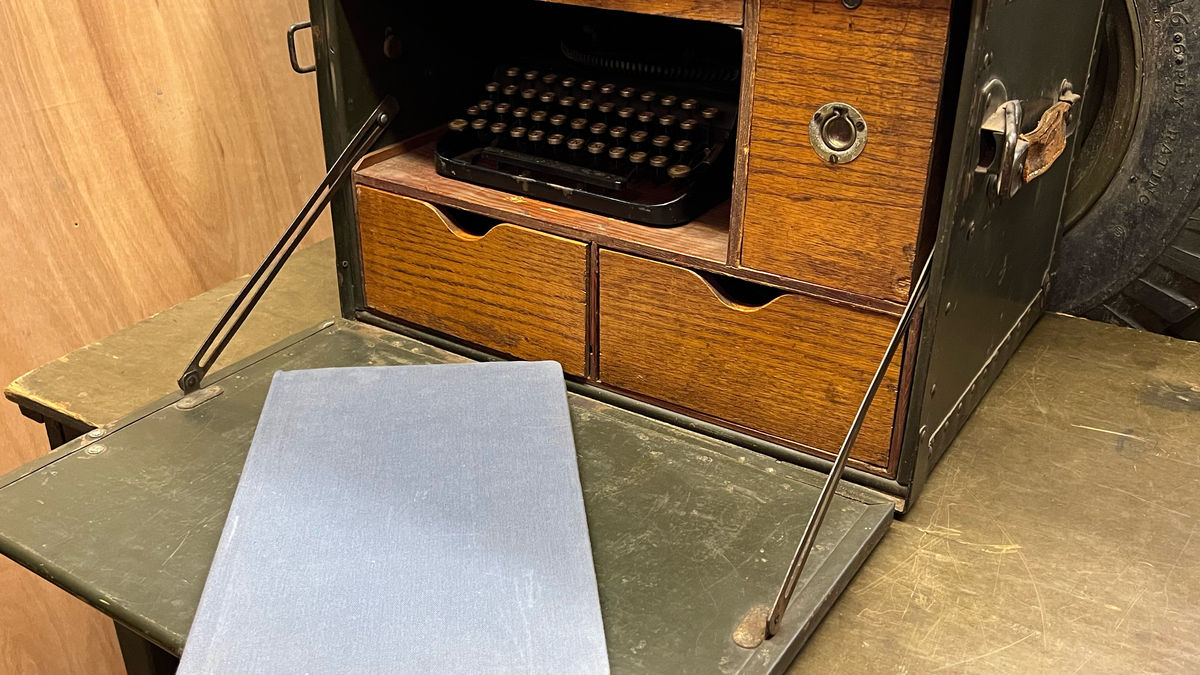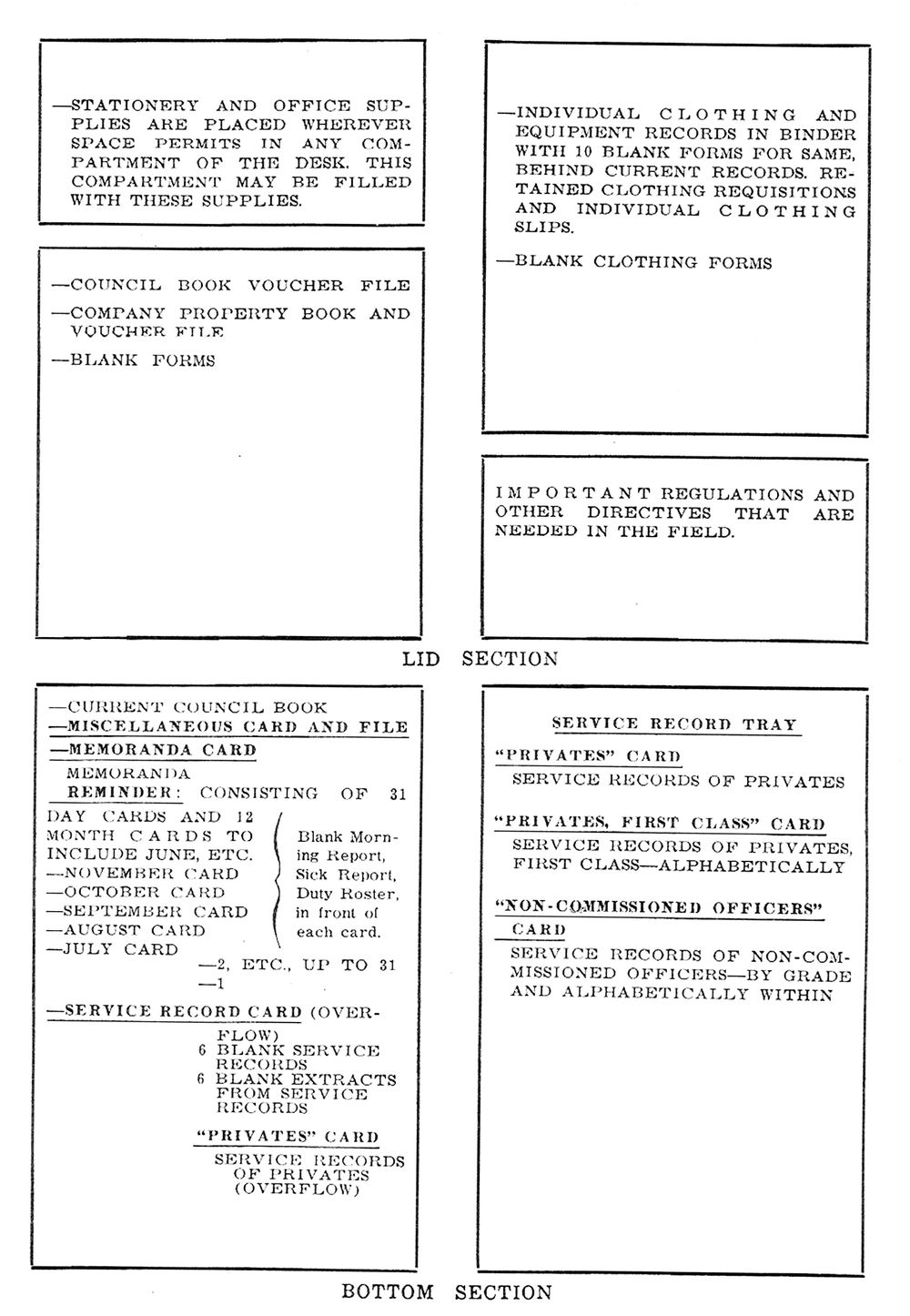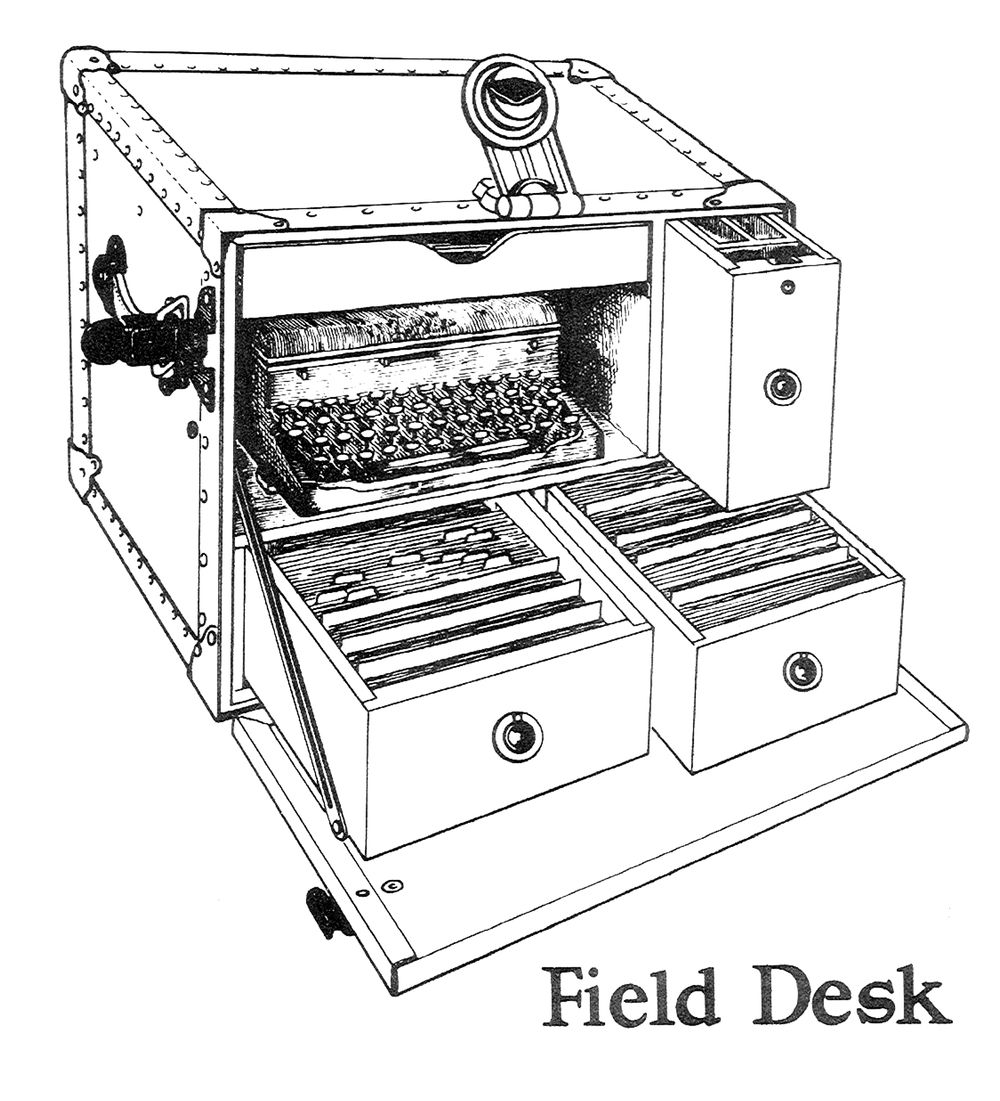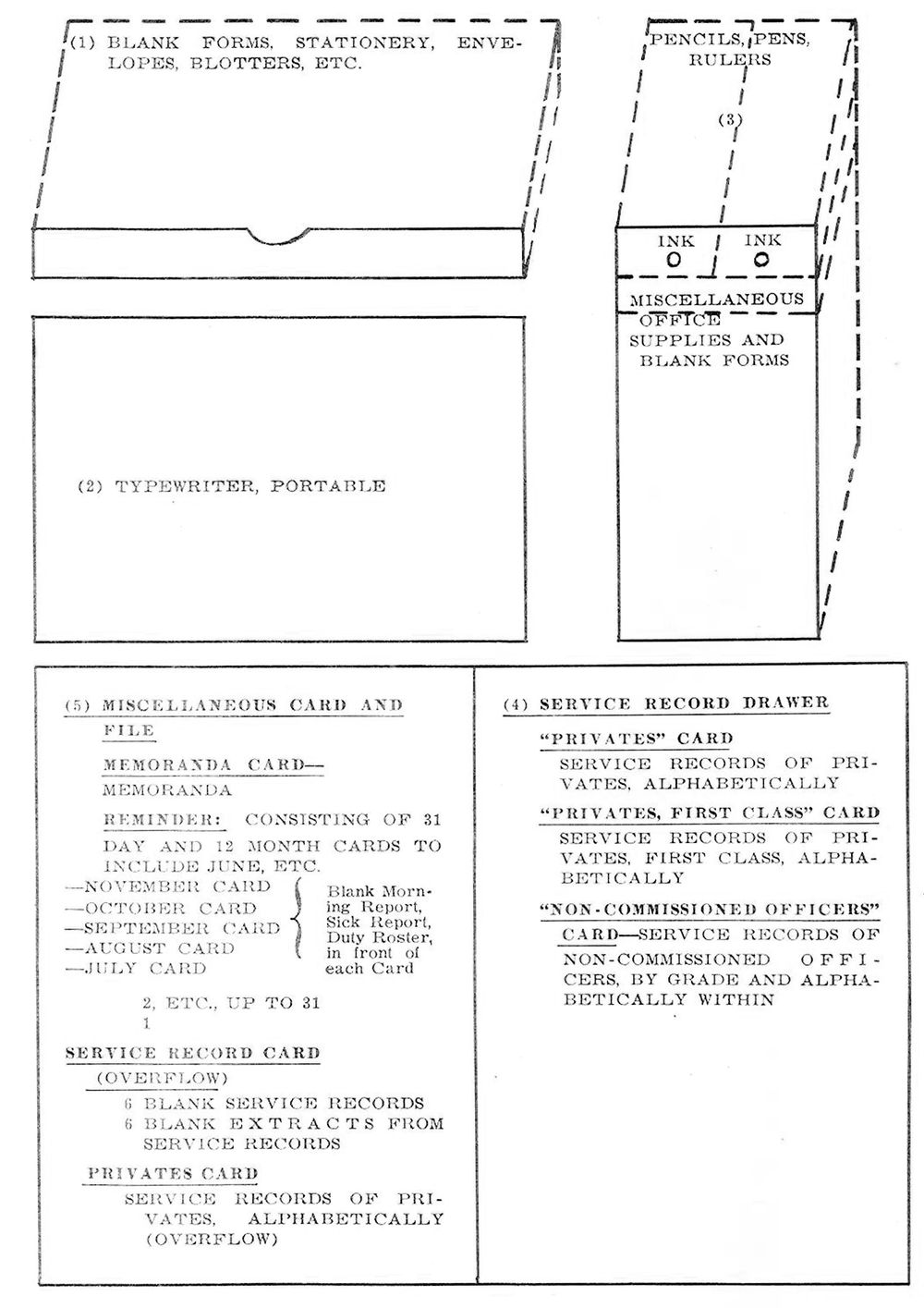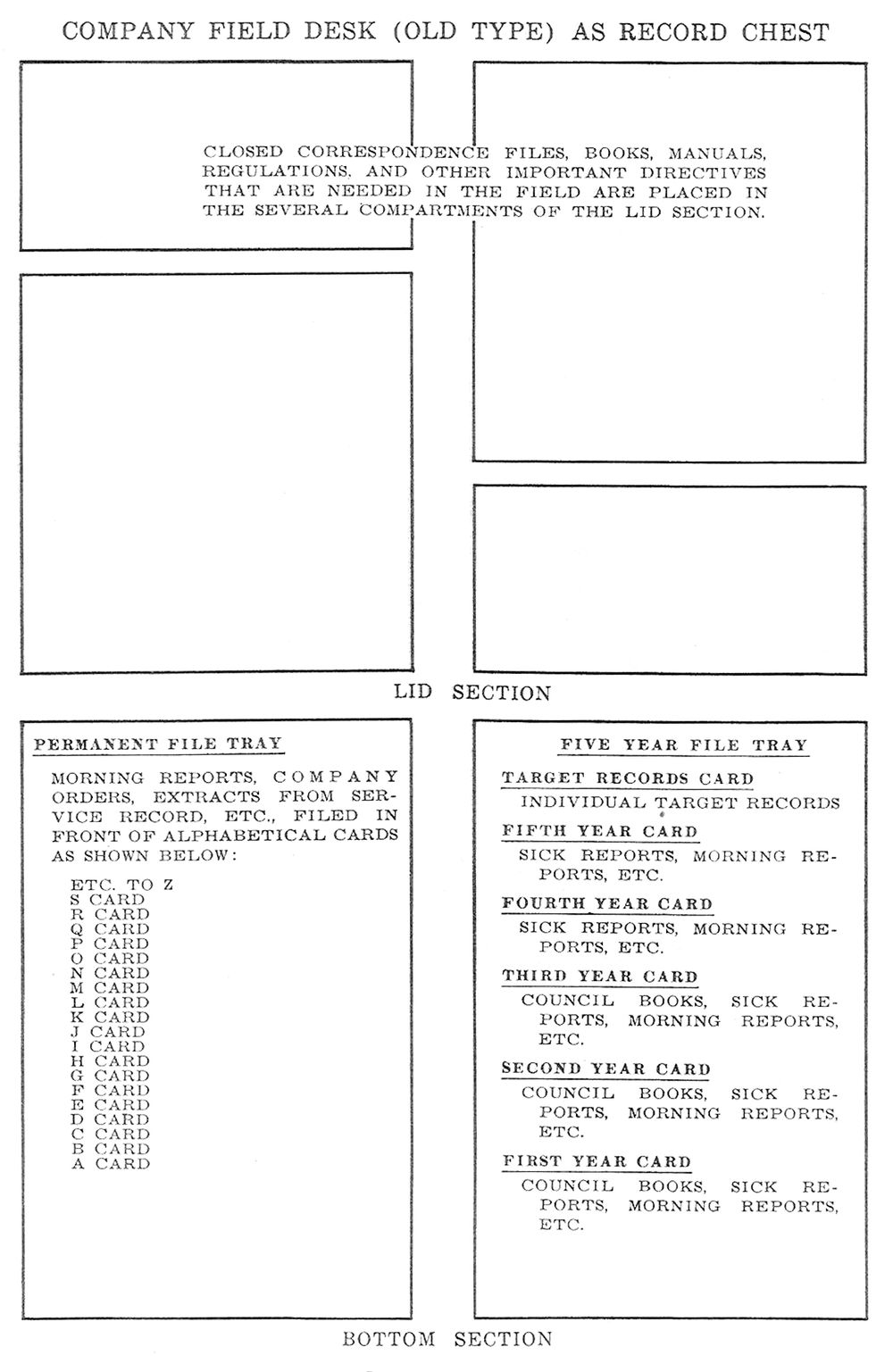The Tables of Equipment (for Infantry, 1 March 1943) provide for one "Desk, Fiber, Field, Empty, Company" and for one "Chest, Fiber, Record, Company" per unit organization (except Medical Detachment). This equipment is prescribed for use in filing and carrying the necessary company records and reports while the organization is in the field, to the exclusion of all other containers.
Two kinds of field desks have been issues (the old "A" and a new improved type). Each unit (except Medical Detachment) should have either type or the other. One type Record Chest is available for issue but not all organizations have received one. Some units are using the old type Field Desk as a Record Chest. All types will be included in these instructions.
In garrison, this equipment is maintained in the unit personnel section at Regimental Headquarters. In the field, the Field Desk and Record Chest are maintained in the unit personnel section in one of the rear echelons.
Except for minor local variations, Company Field Desks and Record Chests throughout the Army are maintained in accordance with the instructions which follow.
The Company Field Desk (Old Type)
The Company Field Desk contains the current records of the organization and a supply of blank forms, stationery, and office supplies sufficient for three months. When the Company goes into the field, this desk is taken along and maintained in the unit personnel section of the Regiment in one of the rear echelons. Figure 2 shows in general the arrangement of records and supplies in this desk.
As will be seen in figure 1, the bottom section of the Field Desk consists of two trays: the "Service Record" tray on the right and the "Miscellaneous" tray on the left. Service Records and miscellaneous records will always be kept in their respective trays in the Field Desk. The trays may be removed temporarily from the desk to facilitate work on the records, but upon completion of the work the records will be returned to the desk.
Service Record Tray:
Service Records will be filed in the tray on the right as follows: In front of the guide card "Noncommissioned Officers" will be filed records of the noncommissioned officers of the Company, arranged by grades and alphabetically within each grade.
Following this group, and in front of the card "Privates, First Class", will be filed the records of the Privates, First Class, in alphabetical order; and in rear of the Privates, First Class, and in front of the guide card "Privates" will be filed the Service Records of the Privates of the Company, in alphabetical order. The tray on the right is not large enough to hold all of the service records of a unit at full T/O strength. The overflow will be maintained in the tray on the left, in front of the "Miscellaneous" record section. Approximately six each blank "Service Records" and "Extracts from Service Records" will be carried in the rear of this file.
Miscellaneous Record Tray
The miscellaneous record section of the tray on the left, contains the "Reminder", "Memoranda", and "Miscellaneous" files in that order from front to rear, followed by the current Council Book.
Reminder File
The "Reminder" consists of the 12 month cards and 31 date (day) cards, which are placed in chronological order in the rear of the Service Records in the tray on the left side, the month cards being in the rear of the date cards. The date cards are rotated as follows: On the morning of January 2 (for example), the date card "1" will be placed in the rear of the January card, and in front of the February card, the procedure being followed daily with the remaining date cards for the month in order, so that on February 1, all the date cards will be arranged in proper order in front of the February card. The January card is then placed behind the December card.
In setting up the "Reminder", a supply of blank Morning Report, Sick Report and Duty Roster forms for the ensuing quarter should be placed in sets in front of each of the next three month cards. Company Commanders must have on hand at all times enough of these forms for three months.
Blank forms for special reports and returns, normally rendered on a specific date, will be filed in front of the date card of the dat on which preparation of the form is to be effected.
A set of Reminder Slips for use in the "Reminder" should be prepared. These slips should anticipate all the items of administration in the Company in time for their accomplishment, and should be prepared in a size of 3 ½ by 8 inches.
The "Reminder" will also be used as a live file for papers destined for the "Five-year" or "Permanent" files (maintained in the Record Chest), but whose disposition in these files is to be postponed until the papers cease to be of current importance.
Such papers should be filed in front of the index card of the month in which they are filed and moved to the back of the "Reminder" with it. When the card next appears, a year later, the papers filed with it will be placed either in the permanent file or in the first-year section of the five-year file.
Memoranda File
In front of the guide card "Memoranda" will be filed memoranda not to be filed elsewhere.
Miscellaneous File
In front of the guide card "Miscellaneous" will be filed such records as W.D., A.G.O. Form No. 43 "Emergency Addressee and Personal Property Card", and W.D., A.G.O. Form No. 303, "Report of Change".
The current Company Council Book and the current Correspondence File will be placed behind the "Miscellaneous" card. Any remaining space will be used for blank forms of a size 3 ½ by 8 inches or smaller, such as "Insert to Service Record".
Blank Forms and Office Supplies
Each Company will take into the field a supply of blank forms and miscellaneous office supplies to meet its normal requirements for a three month period. The items on the lists which follow should be taken along and are generally placed wherever space is available in the Field Desk. Changes may be made to meet local requirements.
Model Forms and Records to taken into the field
| WD | Title |
|---|---|
| 39 | Investigating Officer's Report-Accident, Motor Transportation |
| 366 | Pay Roll |
| 366a | Pay Roll |
| 366b | Pay Roll |
| 370 | Final Statement |
| AGO | |
| 1 | Morning Report |
| 5 | Daily Sick Report |
| 6 | Duty Roster |
| 15 | Report of Survey |
| 20 | Soldier's Qualification Card |
| 24 | Service Record |
| 24, 2-7 | Service Record Inserts |
| 25 | Extract from Service Records |
| 27 | Statement of Accounts |
| 28 | Soldier's Individual Pay Record |
| 29 | Authorization for Allotment of Pay |
| 29-5 | Application for Pay Reservation for Purchase of Defense Savings Bonds |
| 30 | Notification of Discontinuance of Allotment |
| 30-5 | War Savings Bond - Changes in or Cancellation of Class A Pay Reservation |
| 31 | Furlough |
| 32 | Individual Clothing and Equipment Record |
| 35 | Individual Clothing Slip |
| 36 | Statement of Charges |
| 40 | Certificate of Disability for Discharge |
| 43 | Emergency Addressee and Personal Property Card |
| 44 | Report of Desertion |
| 45 | Descriptive List of Deserter or Escaped Military Prisoner from the Army of the United States |
| 46 | Report of Apprehension or Surrender of a Deserter |
| 52 | Report of Death |
| 54 | Inventory of Effects |
| 55 | Honorable Discharge from the Army of the United States |
| 58 | Noncommissioned Officer's Warrant |
| 66-1 | Officer's and Warrant Officer's Qualification Card |
| 77 | Officer's Pay Data Card |
| 110 | Report of Individual Classification in Arms |
| 115 | Charge Sheet |
| 303 | Report of Change |
| 304-A | Locator Card |
| 309 | Initial-Special Final Roster |
| 625 | Application for Family Allowances |
| QMC | |
| 15 | Company Council Book |
| 400 | Requisition |
| 409 | Requisition and Receipt for Clothing in Bulk |
| 424 | Stock Record Form (if used in Company Property Book) |
| 434 | Shipping Ticket |
| 487 | Memorandum Receipt |
| MD | |
| 81 | Immunization Register |
| Standard | |
| 26 | Driver's Report - Accident, Motor Transportation |
| 27 | Investigating Officer's Report - Accident, Motor Transportation |
| Veterans Administration | |
| 350 | Application for National Service Life Insurance |
| 336 | Changes of Beneficiary, National Service Life Insurance |
| Misc. office supplies to be taken into field | |
| 4 | Scratch Pads |
| 40 | Sheets, Letter Paper (first) |
| 40 | Sheets, Letter Paper (tissue) |
| 24 | Sheets, Carbon Paper |
| 24 | Envelopers, Official |
| 1 | Eraser, Ink and Pencil |
| 1 | Eraser, Typewriter |
| 1 | Box, Paper Clips |
| 6 | Blotters |
| 12 | Pen Points |
| 2 | Pen Holders |
| 1 | Bottle, Ink (Blue-Black) |
| 1 | Bottle, Ink (Red) |
| 2 | Pencils, Indelible |
| 2 | Pencils, Lead |
| 2 | Pencils, Colored (Red and Blue) |
| 1 | Tube, Paste |
| 1 | Box, Rubber Bands |
| 1 | Ruler |
| 1 | Cleaning Brush, Typewriter |
| 1 | Can, Oil, Typewriter |
| 1 | Cone, Pins |
| 1 | Box, Thumb Tacks |
The Tables of Equipment (for Infantry, 1 March 1943) provide for one "Typewriter, Portable" on the basis of each Company Field Desk issued. Inasmuch as there is no compartment in the Type "A" Field Desk large enough for this item, it will be necessary for units equipped with this desk to improvise a typewriter container.
The Company Field Desk (New Type)
A new type "Desk, Fiber, Field, Empty, Company" is now being issued to Infantry units (except Medical Detachments) in lieu of the old type known as "Field Desk A". It is expected that the new type will eventually replace all of the older ones in current use. The contents and arrangements of records in the new type necessarily differ from those in the old type because of space variations.
When the unit goes into the field, the new-type Field Desk will contain some of the current personnel records of the organization, a supply of blank forms, stationery, and office supplies sufficient for three months, and the portable typewriter now issued to each Company. The desk is maintained within the unit personnel section of the Regiment in one of the rear echelons.
Figure 3 is a sketch of the new type Field Desk and Figure 4 shows the arrangement of records and supplies within. As can be seen, this desk is divided into five compartments with their contents as follows:
- The top drawer on the left is for stationery, envelopes, blotters and blank forms.
- The open compartment in the left center contains the portable typewriter.
- The drawer on the right is for office supplies and for blank forms. (See lists previously mentioned.)
- The two lower drawers contain the "Service Record File" and "Miscellaneous File". The "Service Record File" starts in the drawer on the right and normally overflows into the drawer on the left.
- The "Miscellaneous Record File" is maintained in the rear of the overflow of Service Records in the left-hand drawer. It consists of the "Reminder," "Memoranda," and "Miscellaneous" files in that order.
Service Record File
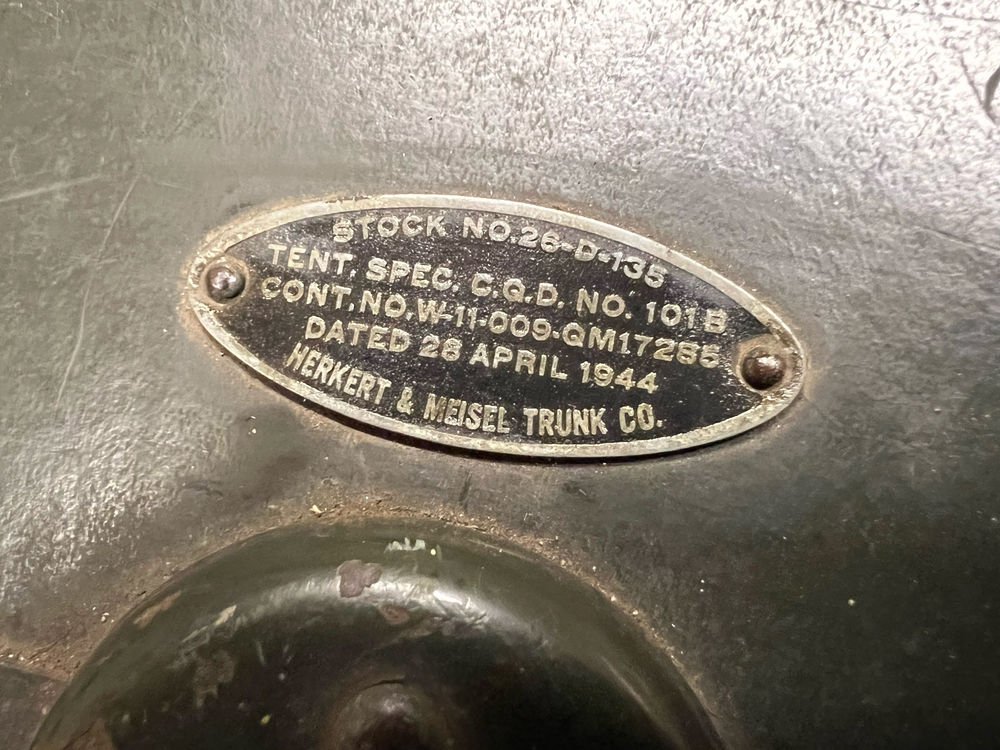
Data plate attached to an original Company Field Desk (New Type - QM Stock Number 26-D-135) built on 26 April 1944 by Herkert & Meisel Trunk Company.
The "Service Record File" will be maintained as follows: In the drawer on the right, in front of the guide card "Noncommissioned Officers", will be filed the service records of the Noncommissioned Officers of the unit, arranged by grade, and alphabetically within each grade. Following this group and in front of the card, "Privates, First Class", will be filed the service records of the Privates, First Class, in alphabetical order. The service records of the Privates of the Company will then be filed alphabetically in front of the guide-card "Privates". The overflow will be filed in the drawer on the left in front of the "Reminder File" of the "Miscellaneous Records" section. Approximately six each blank "Service Records" and "Extracts from Service Records" will be carried in the rear of the "Privates" Section.
Miscellaneous Record Section
The "Miscellaneous Record" section of the drawer in the lower left contains the "Reminder", "Memoranda", and "Miscellaneous" files.
Reminder File
The "Reminder" consists of the 12 month cards and 31 date (day) cards which are placed in chronological order in the rear of the Service Records in the drawer in the lower left, the month cards being in the rear of the date cards. The date cards are rotated as follows: On the morning of January 2 (for example), the date card "1" will be placed in the rear of the January card and in front of the February card, the procedure being followed daily with the remaining date cards for the month in order, so that on February 1, all the date cards will be arranged in proper order in front of the February card. The January card is then placed behind the December card.
In setting up the "Reminder," a supply of blank morning report, sick report, and duty roster forms for the ensuing quarter should be placed in sets in front of each of the next three month cards. Company Commands must have on hand at all times enough of these forms for three months.
Blank forms for special reports and returns, normally rendered on a specific date, will be filed in front of the date card of the day on which preparation of the form is to be effected.
A set of reminder slips for use in the "Reminder" should be prepared. These slips should anticipate all the items of administration in the Company in time for their accomplishment, and should be prepared in a size of 3½ by 8 inches.
The "Reminder" will also be used as a live file for papers destined for the "Five Year" or "Permanent" files (maintained in the Record Chest), but whose disposition in these files is to be postponed until the papers cease to be of current importance. Such papers should be filed in front of the index card of the month in which they are filed and moved to the back of the "Reminder" with it. When the card next appears, a year later, the papers filed with it will be placed either in the permanent file or in the first year section of the five-year file.
Memoranda File
In front of the guide card "Memoranda" will be filed memoranda not to be filed elsewhere.
Miscellaneous File
In front of the guide cards "Miscellaneous" will be filed such records as W.D. A.G.O. Form No. 43, "Emergency Addressee and Personal Property Card," W.D. A.G.O. No. 303, "Report of Change", etc.
Blank Forms and Office Supplies
Each Company will take into the field a supply of blank forms and miscellaneous office supplies to meet its normal requirements for a three-month period. The office supplies are placed in the upper right drawer and the blank forms generally where space is available (see list above). Changes may be made to meet local requirements.
The Company Record Chest (New Type)
This new type "Chest, Fiber, Record, Company," when used in conjunction with the new type Field Desk, will be maintained according to the following instructions. (Refer to Figures 5 and 6.)
Five-Year File
The compartment on the left contains the "Five-Year File". The division cards for this file consist of the "First-Year" through the "Fifth-Year" cards and are designed to classify and separate the records to be retained for five years. When removed from the live file, all records destined for this file, including closed sick reports, morning reports, and council books with allied vouchers will be filed in front of the guide card "First-Year". On January 1st of each year, the papers in the fifth-year section are removed and destroyed, except those for the file in the "Permanent File". The papers in the fourth-year section are then moved to the fifth-year section; those in the third-year section to the fourth-year section, and so on, thereby opening the first-year section to the records for the "Five-Year File". This procedure is repeated at the start of each year. Retained "Individual Target Records" are maintained in this compartment below the "Five-Year File". Closed "Correspondence Files" are also stored here. Any remaining space may be used for blank forms, manuals, regulation, etc.
Permanent File
The two compartments on the right are used for the "Permanent File", which includes the following records that must be maintained permanently within the Company: Extracts from Service Records; closed Morning Reports; Daily Sick Reports (8 years); Monthly Roster of Troops; Company Returns, if rendered; and documents of a permanent nature but not of current importance. Any paper or other document in a closed "Correspondence File" which relates to the history of the organization or to individuals or to records of future value will be retained permanently (see AR 345-620) in envelopes 9½ by 12½ inches as part of this file. The closed "Correspondence File" will be stored in the compartment on the left (Five-Year File section) because of the size of the envelopes involved. Extracts from Service Records are removed from the individual record drawers of the Field Desk to the alphabetical section of the permanent file one year from the date on which they were closed. The "Permanent File" is maintained alphabetically beginning at the left of the upper compartment. Blank forms may be placed in these compartments if there is available space.
Miscellaenous
The drawer at the top contains the current Company "Council Book" and allied Voucher files; the Company "Property Book" and allied Voucher files; the Individual Clothing and Equipment Records (AGO Form Nos. 32 & 33) in a binder with 10 extra forms in the rear; and any retained clothing requisitions and individual clothing slips (AGO Form No. 35). Any remaining space will be used for blank forms, manuals, regulations, and other important directives that are needed in the field.
Company Field Desk (Old Type) as Record Chest
The instructions which follow apply to the use of the old-type Company Field Desk as a Record Chest. Some organizations are no doubt using them as such, in lieu of the new type Record Chest. Refer to Figures 7 and 8.
Five-Year File
This file is maintained in the tray on the right in the bottom section. The division cards for this file consist of the "first-year", "second-year", "third-year", "fourth-year", and "fifth-year" cards designed to classify and separate the papers to be retained for five years. All papers destined for the five-year file including Sick Reports, Morning Reports, and Company Council Books, when withdrawn from the live file, will be filed in front of the guide card "first-year."
On January 1st of each year, the papers in the fifth-year section are removed and destroyed, except those for file in the "Permanent File", The papers in the fourth-year section are then moved to the fifth-year section; those in the third-year section to the fourth-year section, and so on, thereby opening the first-year section for papers destined for the "Five-Year File". This procedure is repeated at the start of each year.
Retained "Individual Target Records" are also maintained in the lower right tray, behind the "Five-Year File".
The Permanent File
This file is maintained alphabetically in the tray on the left in the bottom section. The following records will be placed in the "Permanent File": Extracts from Service Records; closed Morning Reports; Daily Sick Reports (8 years); Monthly Roster of Troops; Company Returns, if rendered; all Company Orders; and documents of a permanent nature but not of current importance. Any paper or other document in a closed "Correspondence File" which relates to the history of the organization or to individuals or to records of future value will be retained permanently (see AR 345-620) in envelopes 9½ by 12½ inches as part of this file. The closed "Correspondence Files" will be stored in the lid section because of the size of the envelopes involved. Extracts from Service Records are removed from the individual record tray of the Field Desk to the alphabetical section of the "Permanent File" one year from the date on which they are closed.
Miscellaneous
The several compartments of the lid section are used to hold books, manuals, regulations, directives of a permanent nature, and closed "Correspondence Files", as space permits.

